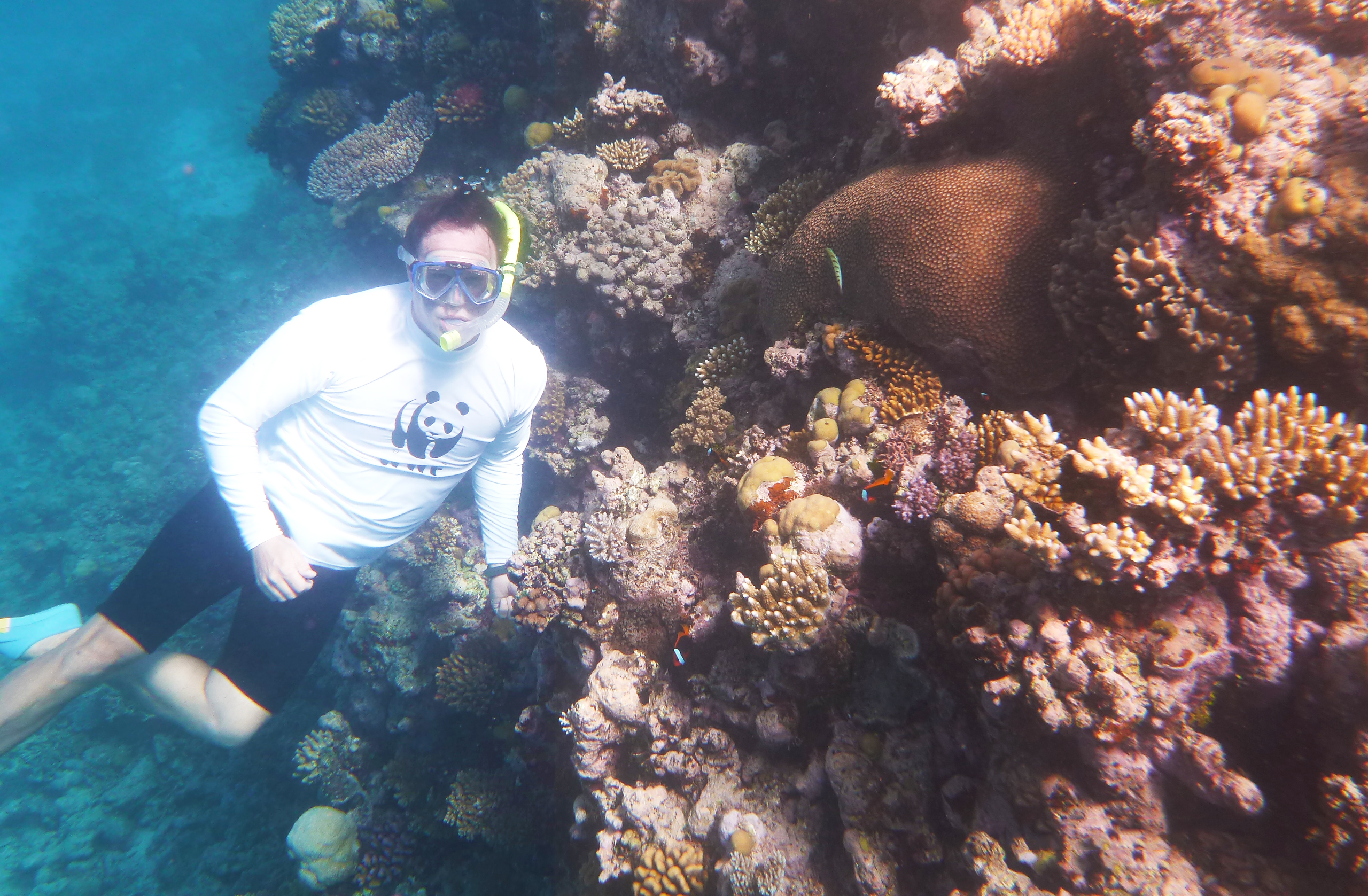As CEO of WWF-Australia since 2010, Dermot O’Gorman brings more than 20 years of conservation experience to the role. Dermot grew up on the NSW South Coast and started by working as a ranger. Since then he takes a big picture approach to conservation, actively engaging with community groups, businesses and international organisations to work towards a healthier planet. From Australia to China, Fiji, the UK and Switzerland, Dermot has worked on projects that aim to create a world where humans live in greater harmony with nature.
“It doesn’t get much better than this!” I thought snorkelling above breathtaking coral and thousands of coloured fish. It was a magical morning earlier this month and I was exploring a pristine reef near Lizard Island 270 km north of Cairns. So why is WWF-Australia so worried about the Great Barrier Reef if this patch looks so good? That’s because sadly there has been a serious decline in the majority of the reef – especially those areas near ports, cities and major farming activity. Coral and seagrass are dying and so are turtles, dugongs and other marine life. The WWF-Australia team travelled to Lizard Island to talk to marine researchers, to remind us all what a healthy reef looks like, and to focus on the fight ahead.
You might have heard that the latest threat to the reef comes from rapid industrialisation and I want to explain what’s been happening and what you can do about it. Right now along the reef coastline there are big port expansions either underway, soon to commence, or on the drawing board. These projects propose a massive amount of dredging to create new shipping channels. Giant vacuum cleaners suck up the seabed. If it’s not disposed of on land it’s transported on a barge to another location and dumped at sea. Why is this a problem? Because dredge spoil doesn’t just sink to the bottom, it stays suspended in the water and can be carried by winds and currents for up to 80 kilometres. It harms coral and seagrass by smothering them or blocking the sun. The destruction from dredge spoil can continue for months and even years as storms resuspend it repeatedly. Dredging also stirs up and redistributes toxins that had settled in the seabed.
Controversy surrounds these dredging programs. For example a bund wall in Gladstone built to contain the spoil in a land reclamation area failed. Fishermen started catching fish with red lesions and sores and there was a big spike in turtle and dugong deaths.
The Federal Environment Minister quite rightly announced an inquiry into the leaking bund wall while fishers have launched a class action over losses in their industry. Gladstone continues to ring alarm bells and there is great concern about plans for Abbot Point – just 50 kilometres from the beautiful Whitsunday Islands.
A proposed expansion at Abbot Point involves the dredging of three million cubic metres of seabed to be dumped in the marine park. To put that amount of spoil into perspective if it was placed in dump trucks lined up end to end they would stretch from Brisbane to Melbourne. Such is the concern about this that 240 leading Australian scientists signed a joint letter urging for the dumping not to go ahead because the reef is already in such a fragile state that all future impacts must be minimised. It said in part:
The best available science, including the recent report commissioned by GBRMPA on transport of disposed dredge sediment, makes it very clear that expansion of the port at Abbot Point will have detrimental effects on the Great Barrier Reef. Sediment from dredging can smother corals and seagrasses and expose them to poisons and elevated nutrientS – Full statement here
The WWF believes that to dump dredge spoil anywhere within the Great Barrier Reef World Heritage Area is just plain wrong. It’s not just scientists and conservationists who feel that way. More and more Australians, not prepared to sit back and accept what’s happening to the reef, have started to mobilise. They’ve signed petitions, marched in the street, reached into their wallets and donated.
Despite the growing opposition, the Federal Government and the Great Barrier Reef Marine Park Authority approved the Abbot Point dumping. The world is watching. UNESCO’s World Heritage Committee has expressed “extreme concern” over the pace and scale of industrialisation along the Reef’s coast and warned that the Great Barrier Reef could be declared ‘World Heritage in danger’. Worldwide alarm over the state of the reef is backed up by our own government’s Great Barrier Reef Outlook report which says the reef is at a crossroads and under significant pressure. The Outlook report said sediment run off from grazing areas and agricultural chemical run off from high intensity cropping are having significant effects on the reef. Excess nutrients cause an increase in algae which feeds juvenile Crown of Thorns Starfish causing more frequent outbreaks of these coral-eating creatures. Climate Change, according to the Outlook report, is already impacting the reef and its effects will increase as the ocean becomes warmer and more acidic. In addition scientists believe climate change will cause more destructive cyclones. Talk of cyclones and Crown of Thorns Starfish takes me back to Lizard Island. Researchers there are testing a new control method. Ox bile encourages a naturally occurring virus to kill the pest with just one injection whereas the previous chemical substance used required multiple shots. Just days after I joined scientists diving to hunt for these starfish Lizard Island had to be evacuated as Tropical Cyclone Ita approached as a category 5 storm. It was a dramatic reminder of scientists’ predictions of more severe cyclones and concern over the impact that will have on the reef.
There’s no doubt the reef faces many challenges, but the good news is there are solutions. Farmers are working to reduce run off but we need to help them to do much more. We need to be thinking billions not millions of dollars to reduce pollution whilst improving on-farm productivity. Science tells us the reef will be increasingly impacted by climate change so we must boost efforts to transition away from burning dirty fossil fuels, like coal and gas, and move towards clean, renewable energy sources such as wind and solar. Likewise there are alternatives to dumping dredge waste on the reef. For a start there is spare capacity in our existing ports so managing port infrastructure more efficiently would eliminate the need for expansions and dredging. For its part WWF will continue to help Australians give the reef a voice.
Last year as the World Heritage Committee held its annual meeting, with the reef high on its agenda, WWF organised a twitter storm to show the Committee the depth of global concern. The exposure was remarkable with #FightfortheReef appearing 93.5 million times in the Twittersphere and stars such as Miley Cyrus and Liam Hemsworth sending out tweets. This year as the World Heritage Committee prepares to meet again WWF will once more help people across the globe demonstrate their love of the reef and their demand for action.
Words by Dermot O’Gorman, Chief Executive Officer, WWF-Australia
For more information on WWF’s ‘Fight for the Reef’ Campaign and how you can get involved go to http://www.wwf.org.au/reef










I would fight for the reef by marching or demonstrating here in Melbourne. This is an outrage this fast track to destroy our reef. To be sustainable is where we all should be heading, but not this government. I am sick with anger at what is being done.
Please arrange something so that we can show the world what we think.
Kindest Regards,
Comments are closed.